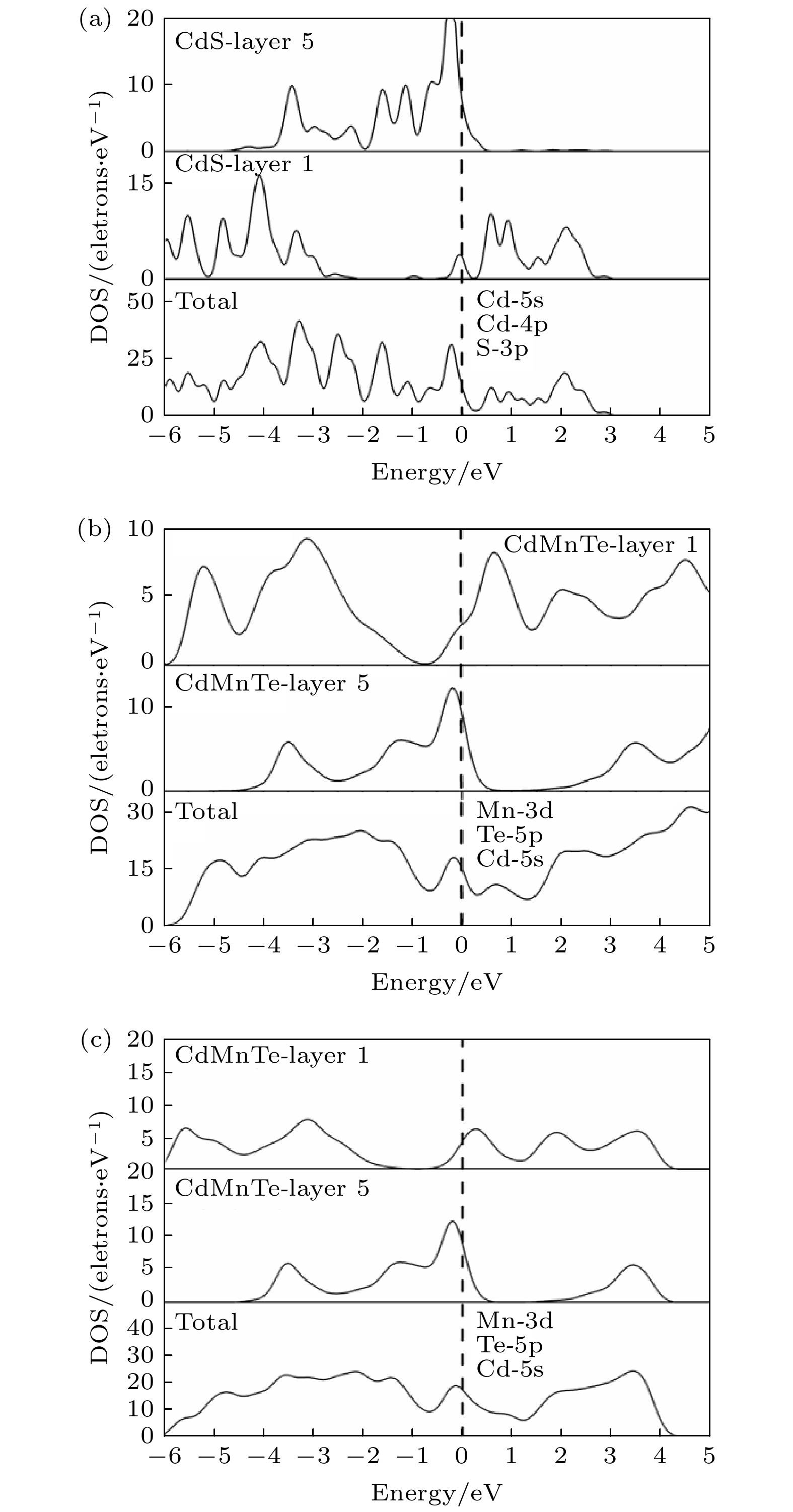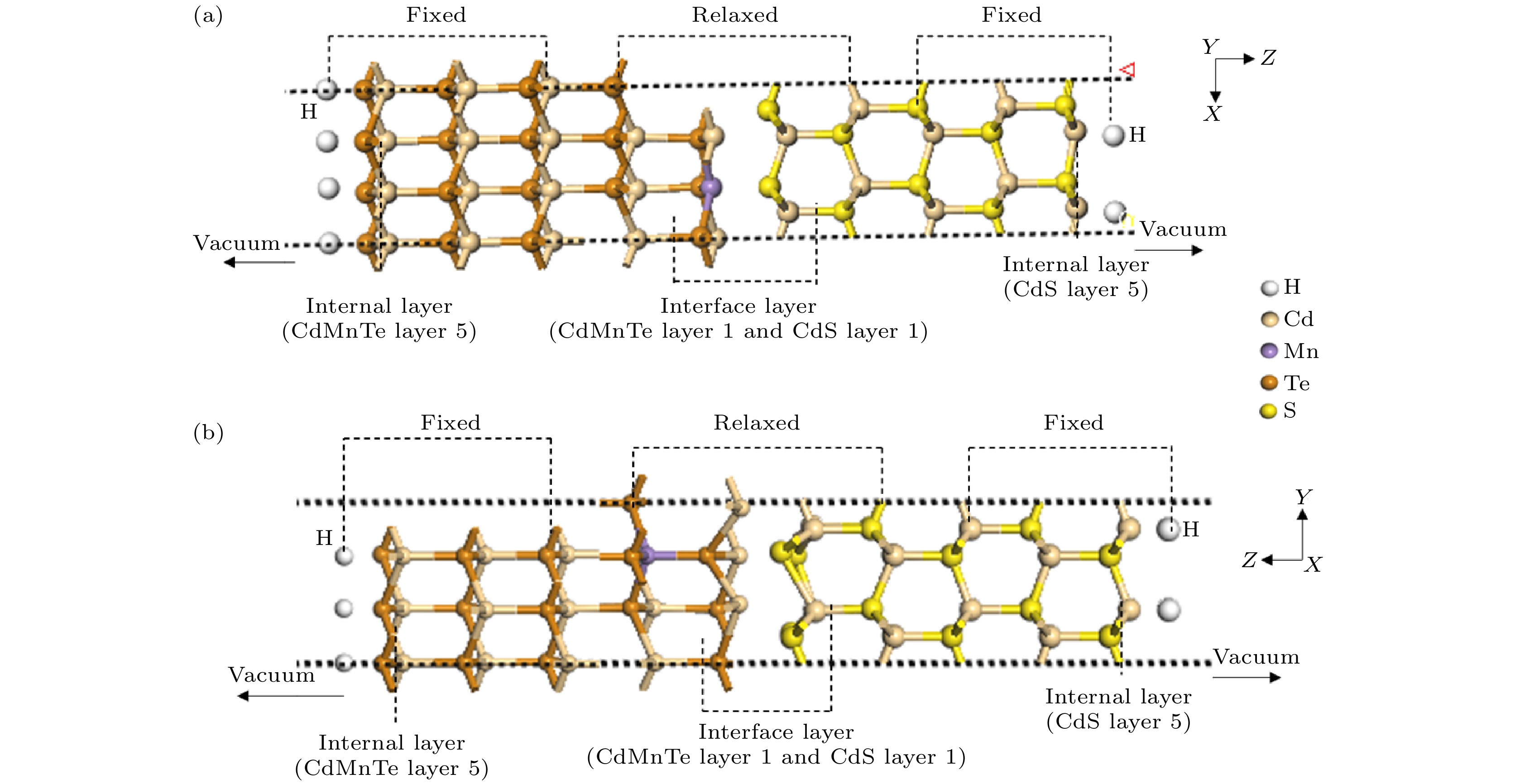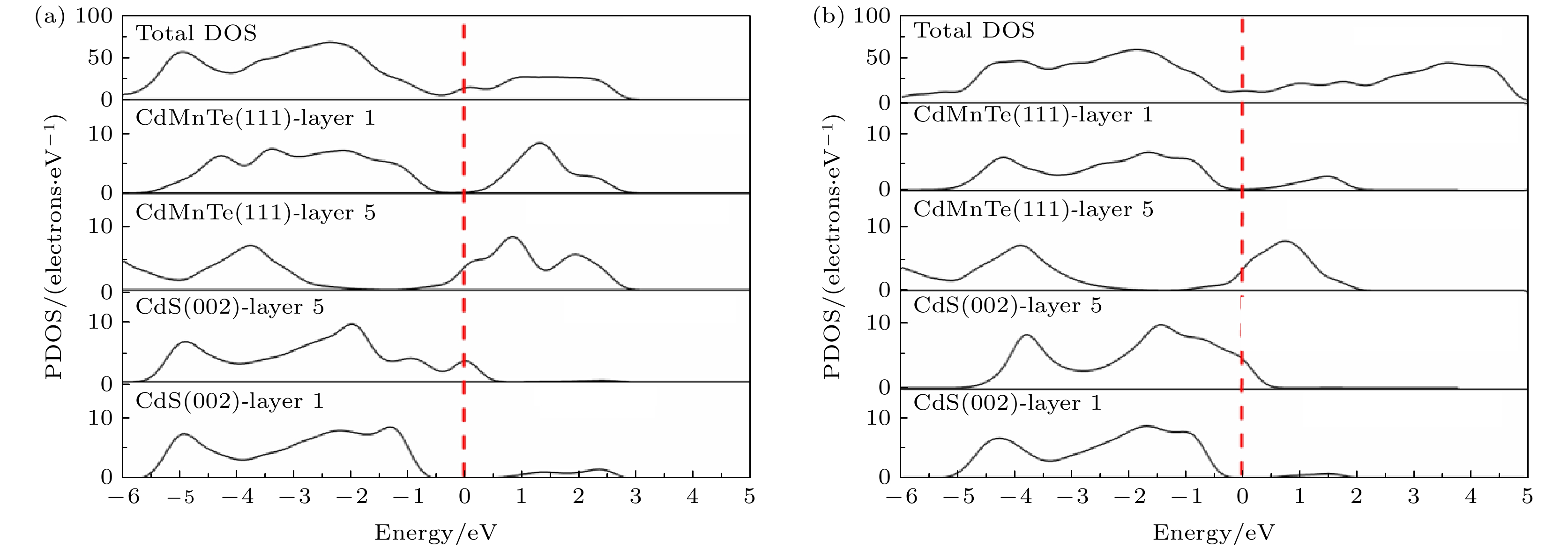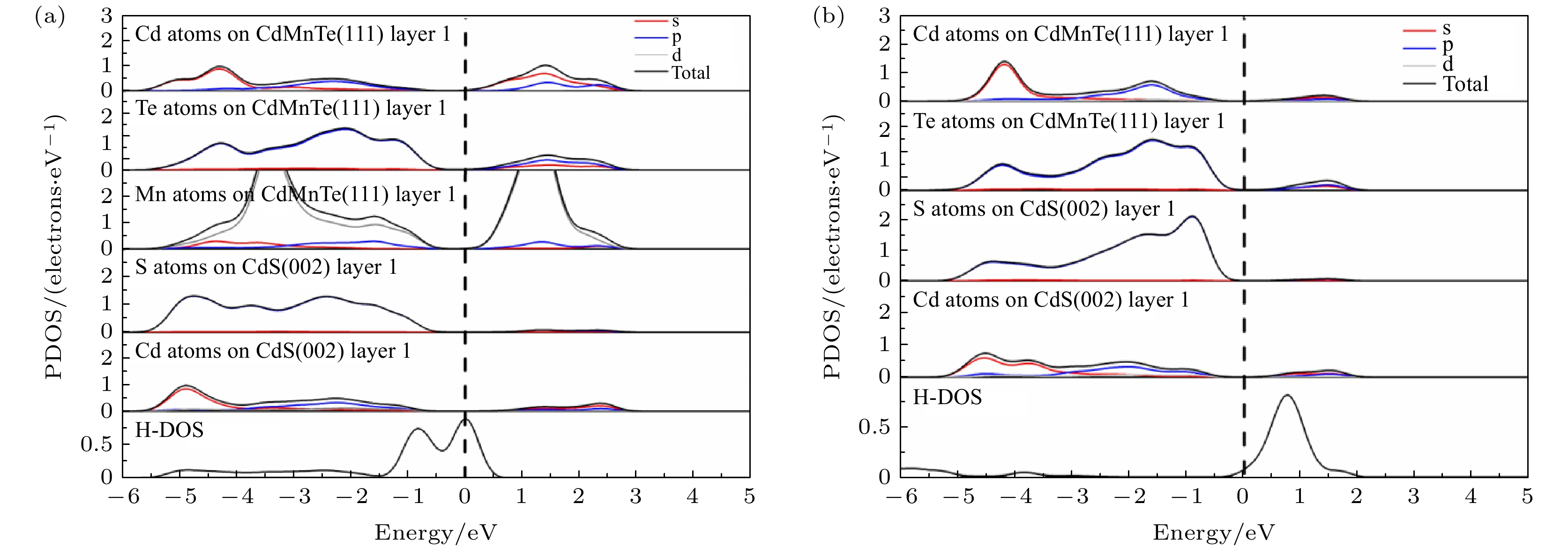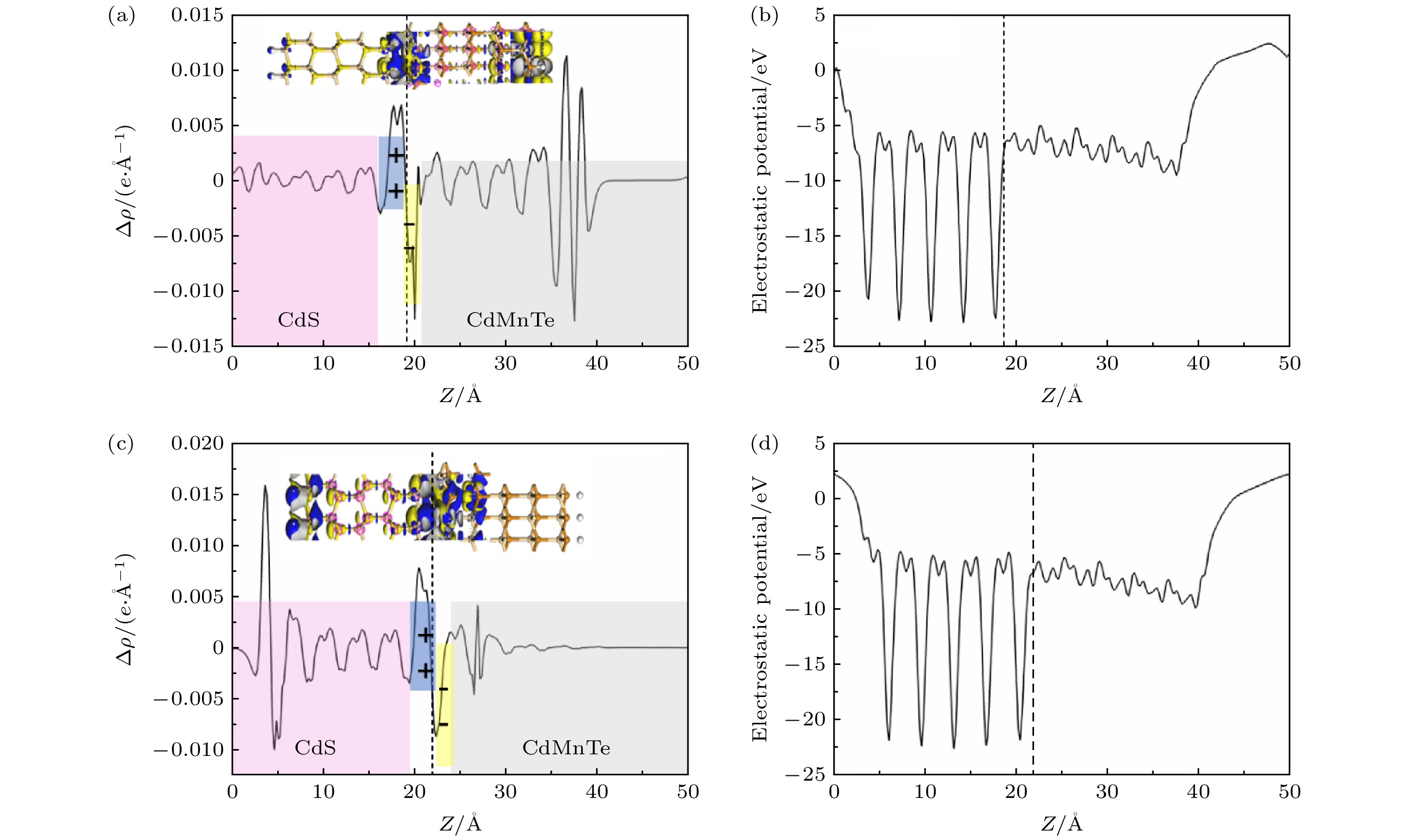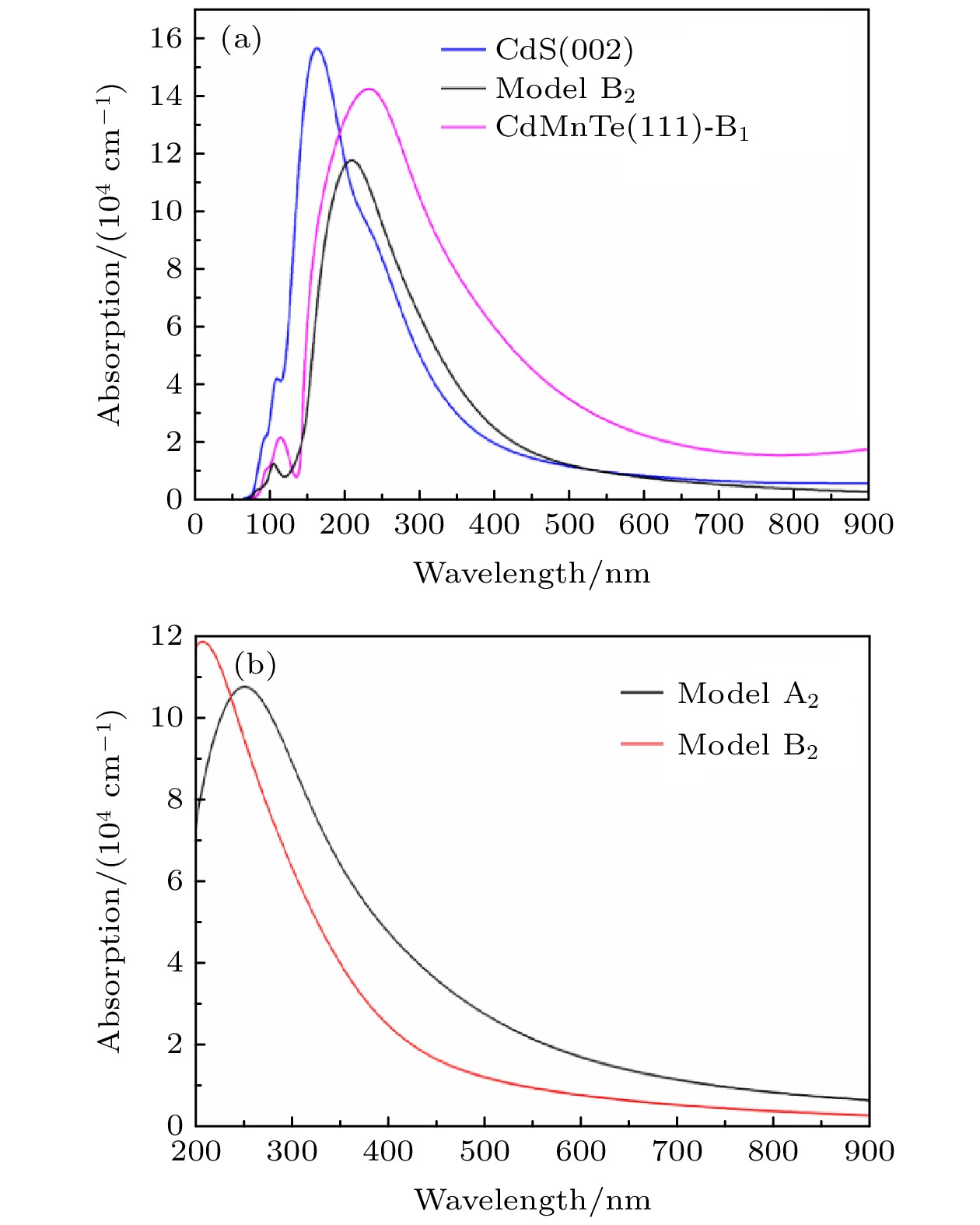-
CdS/CdMnTe heterojunction is the core of photoelectric conversion of CdMnTe film solar cells, whose interface properties have an important influence on the cell efficiency. In this study, the first-principles calculation method based on density functional theory is used to build the surface model for each of the CdS (002) and the CdMnTe (111) and the model of CdS/CdMnTe heterojunction with Mn atoms occupying different positions, and to analyze their electronic properties and optical properties. The results show that the lattice mismatch of the CdS/CdMnTe heterojunction is about 3.5%, the atomic positions and bond lengths of the interface change slightly after relaxation. The density of states shows that there is no interface state near the Fermi level in CdS/CdMnTe interface. Besides, the atoms at CdS/CdMnTe interface are hybridized, which can enhance the interface bonding. The differential charge density analyses indicate that the charge transfer mainly occurs at the interface, and electrons transfer from CdMnTe to CdS. The optical analysis shows that CdS/CdMnTe heterojunction mainly absorbs ultraviolet light, and the absorption coefficient can reach 105 cm–1. However, the optical properties of heterojunctions with different Mn atom positions are slightly different. In a range of 200–250 nm, the absorption coefficient of the heterojunction with Mn atom in the middle layer is larger, but in a range of 250–900 nm, the absorption peak of the heterojunction with Mn atom in the interface layer is higher. The results in this paper can provide some references for improving the photoelectric conversion efficiency of stacked solar cells through the reasonable construction of the heterojunction model and the analysis of the interface photoelectric performance, which is beneficial to the experimental research of multi-band gap heterojunction.
-
Keywords:
- CdS/CdMnTe heterojunction /
- first-principles /
- density of states /
- optical properties
[1] 朱建国, 孙小松, 李卫 2007 电子与光电子材料 (北京: 国防工业出版社) 第125页
Zhu J G, Sun X S, Li W 2007 Electronic and Optoelectronic Materials (Beijing: Defense Industry Press) p125 (in chinese)
[2] Miles R W, Hynes K M, Forbes I 2005 Prog. Cryst. Growth Charact. Mater. 51 1
 Google Scholar
Google Scholar
[3] Mishima T, Taguchi M, Sakata H, Maruyama E 2011 Sol. Energy Mater. Sol. Cells 95 18
 Google Scholar
Google Scholar
[4] Jordan D, Nagle J P 1994 Prog. Photovoltaics 2 171
 Google Scholar
Google Scholar
[5] Cheng Y J, Yang S H, Hsu C S 2009 Chem. Rev. 109 5868
 Google Scholar
Google Scholar
[6] Mora-Seró I, Bisquert J 2010 J. Phys. Chem. Lett. 1 3046
 Google Scholar
Google Scholar
[7] Zhao J 2004 Sol. Energy Mater. Sol. Cells 82 53
 Google Scholar
Google Scholar
[8] Cojocaru-Miredin O, Choi P, Wuerz R, Raabe D 2011 Appl. Phys. Lett. 98 73
 Google Scholar
Google Scholar
[9] Yang L, Xuan Y, Tan J 2011 Opt. Express 19 A1165
 Google Scholar
Google Scholar
[10] Chopra K L, Paulson P D, Dutta V 2004 Prog. Photovoltaics 12 69
 Google Scholar
Google Scholar
[11] Zhang K, Guo H 2017 J. Mater. Sci. Mater. Electron. 28 17044
 Google Scholar
Google Scholar
[12] Wu X 2004 Sol. Energy 77 803
 Google Scholar
Google Scholar
[13] Chander S, De A K, Dhaka M S 2018 Sol. Energy 174 757
 Google Scholar
Google Scholar
[14] Chander S, Dhaka M S 2016 Phys. E 84 112
 Google Scholar
Google Scholar
[15] Lee S H, Gupta A, Wang S, Compaan A D, McCandless B E 2005 Sol. Energy Mater. Sol. Cells 86 551
 Google Scholar
Google Scholar
[16] Chander S, Dhaka M S 2019 Sol. Energy 183 544
 Google Scholar
Google Scholar
[17] Rohatgi A, Ringel S A, Welch J, Meeks E, Pollard K, Erbil A, Summers C J, Meyers P V 1988 Sol. Energy 24 185
[18] Luan L J, Gao L, Lv H H, Yu P F, Wang T, He Y, Zheng D 2020 Sci. Rep. 10 1
 Google Scholar
Google Scholar
[19] Wang S L, Lee S H, Gupta A 2004 MRS Proc. 836 L5.39
 Google Scholar
Google Scholar
[20] 侯泽荣, 万磊, 白治中, 王德亮 2010 中国科学技术大学学报 40 718
 Google Scholar
Google Scholar
Hou Z R, W L, Bai Z Z, Wang D L 2010 J. Univ. Sci. Tech. Chin. 40 718
 Google Scholar
Google Scholar
[21] Olusola O I, Madugu M L, Ojo A A, Dharmadasa I M 2020 J. Mater. Sci. Mater. Electron. 31 22151
 Google Scholar
Google Scholar
[22] Shafaay B A 2014 J. Chem., Biol. Phys. Sci. 4 1
[23] Gueddim A, Madjet M E, Zerroug S, Bouarissa N 2016 Opt. Quantum Electron. 48 551
 Google Scholar
Google Scholar
[24] Llchuk H, Zmiiovska E, Petrus R, Semkive I, Lopatynskyi I, Kashuba 2020 J. Nano-Electron. Phys. 12 01027
 Google Scholar
Google Scholar
[25] Cao A, Tan T T, Zhang H, Du Y, Sun Y, Zha G 2018 Phys. B 545 323
 Google Scholar
Google Scholar
[26] Merad A, Kanoun M, Merad G, Cibert J, Aourag H 2005 Mater. Chem. Phys. 92 333
 Google Scholar
Google Scholar
[27] Liu H X, Tang F L, Xue H T, Zhang Y, Cheng Y W, Feng Y D 2016 Chin. Phys. B 25 123101
 Google Scholar
Google Scholar
[28] Shenoy S, Tarafder K 2020 J. Phys. Condens. Matter 32 275501
 Google Scholar
Google Scholar
[29] Kresse G, Joubert D 1999 Phys. Rev. B 59 1758
 Google Scholar
Google Scholar
[30] Shi L B, Xu C Y, Yuan H K 2011 Phys. B 406 3187
 Google Scholar
Google Scholar
[31] Perdew J P, Burke K, Ernzerhof M 1996 Phys. Rev. Lett. 77 3865
 Google Scholar
Google Scholar
[32] Butler K T, Frost J M, Walsh A 2015 Mater. Horiz. 2 228
 Google Scholar
Google Scholar
[33] Wang J S, Tong S C, Tsai Y H, Tsai W J, Yang C S, Chang Y H, Shen J L 2015 J. Alloys Compd. 646 129
 Google Scholar
Google Scholar
[34] Kumar S G, Rao K S R K 2014 Energy Environ. Sci. 7 45
 Google Scholar
Google Scholar
[35] Cheng Y W, Tang F L, Xue H T, Liu H X, Gao B, Feng Y D 2016 Mater. Sci. Semicond. Process. 45 9
 Google Scholar
Google Scholar
[36] Momma K, Izumi F 2008 J. Appl. Crystallogr. 41 653
 Google Scholar
Google Scholar
[37] Guo Y, Xue Y, Geng C, Li C, Li X, Niu Y 2019 J. Phys. Chem. C 123 16075
 Google Scholar
Google Scholar
[38] Yin W J, Shi T, Yan Y 2015 J. Phys. Chem. C 119 5253
 Google Scholar
Google Scholar
[39] Scharber M C, Mühlbacher D, Koppe M, Denk P, Waldauf C, Heeger A J, Brabec C J 2006 Adv. Mater. 18 789
 Google Scholar
Google Scholar
[40] Sharma S, Devi N, Verma U P, RajaRam P 2011 Phys. B 406 4547
 Google Scholar
Google Scholar
[41] Dadsetani M, Pourghazi A 2006 Phys. Rev. B 73 195102
 Google Scholar
Google Scholar
[42] Gajdos M, Hummer K, Kresse G, Furthmueller J, Bechstedt F 2006 Phys. Rev. B 73 045112
 Google Scholar
Google Scholar
-
图 9 电荷重新分布图 (a), (c)异质结A2与B2的差分电荷示意图和相应平面差分电荷密度曲线, 黄色区域代表电荷消耗, 蓝色区域代表电荷积累, 等值面值为0.00103 e/Å3; (b), (d) A2与B2沿z轴方向的平均静电势
Figure 9. Distribution diagram of charges: (a), (c) Charge density difference and the corresponding planar differential charge density curve of the A2 model and B2 model, respectively. The yellow region represents charge depletion, the bule region indicates charge accumulation, the isosurface value is 0.00103 e/Å3. (b), (d) the average electrotactic potential difference of the A2 model and B2 model, respectively, along the direction of z axis.
表 1 CdTe和CdS晶格参数优化结果
Table 1. Optimal lattice parameters of CdTe and CdS.
表 2 弛豫后CdMnTe (111)和CdS (002)表面层间距离的变化
Table 2. Variations of interlayer spacing of CdMnTe (111) and CdS (002) surfaces after relaxation.
Surface items d1-2/Å d2-3/Å d3-4/Å d4-5/Å CdMnTe-A1 dCd-Te 2.829 2.837 2.831 2.831 dMn-Te 2.605 ∆d 0.138 0.089 0.000 0.000 CdMnTe-B1 dCd-Te 2.791 2.841 2.831 2.831 dMn-Te 2.697 ∆d 0.182 0.093 0.000 0.000 CdS dCd-S 2.534 2.538 2.536 2.536 ∆d 0.120 0.109 0.000 0.000 -
[1] 朱建国, 孙小松, 李卫 2007 电子与光电子材料 (北京: 国防工业出版社) 第125页
Zhu J G, Sun X S, Li W 2007 Electronic and Optoelectronic Materials (Beijing: Defense Industry Press) p125 (in chinese)
[2] Miles R W, Hynes K M, Forbes I 2005 Prog. Cryst. Growth Charact. Mater. 51 1
 Google Scholar
Google Scholar
[3] Mishima T, Taguchi M, Sakata H, Maruyama E 2011 Sol. Energy Mater. Sol. Cells 95 18
 Google Scholar
Google Scholar
[4] Jordan D, Nagle J P 1994 Prog. Photovoltaics 2 171
 Google Scholar
Google Scholar
[5] Cheng Y J, Yang S H, Hsu C S 2009 Chem. Rev. 109 5868
 Google Scholar
Google Scholar
[6] Mora-Seró I, Bisquert J 2010 J. Phys. Chem. Lett. 1 3046
 Google Scholar
Google Scholar
[7] Zhao J 2004 Sol. Energy Mater. Sol. Cells 82 53
 Google Scholar
Google Scholar
[8] Cojocaru-Miredin O, Choi P, Wuerz R, Raabe D 2011 Appl. Phys. Lett. 98 73
 Google Scholar
Google Scholar
[9] Yang L, Xuan Y, Tan J 2011 Opt. Express 19 A1165
 Google Scholar
Google Scholar
[10] Chopra K L, Paulson P D, Dutta V 2004 Prog. Photovoltaics 12 69
 Google Scholar
Google Scholar
[11] Zhang K, Guo H 2017 J. Mater. Sci. Mater. Electron. 28 17044
 Google Scholar
Google Scholar
[12] Wu X 2004 Sol. Energy 77 803
 Google Scholar
Google Scholar
[13] Chander S, De A K, Dhaka M S 2018 Sol. Energy 174 757
 Google Scholar
Google Scholar
[14] Chander S, Dhaka M S 2016 Phys. E 84 112
 Google Scholar
Google Scholar
[15] Lee S H, Gupta A, Wang S, Compaan A D, McCandless B E 2005 Sol. Energy Mater. Sol. Cells 86 551
 Google Scholar
Google Scholar
[16] Chander S, Dhaka M S 2019 Sol. Energy 183 544
 Google Scholar
Google Scholar
[17] Rohatgi A, Ringel S A, Welch J, Meeks E, Pollard K, Erbil A, Summers C J, Meyers P V 1988 Sol. Energy 24 185
[18] Luan L J, Gao L, Lv H H, Yu P F, Wang T, He Y, Zheng D 2020 Sci. Rep. 10 1
 Google Scholar
Google Scholar
[19] Wang S L, Lee S H, Gupta A 2004 MRS Proc. 836 L5.39
 Google Scholar
Google Scholar
[20] 侯泽荣, 万磊, 白治中, 王德亮 2010 中国科学技术大学学报 40 718
 Google Scholar
Google Scholar
Hou Z R, W L, Bai Z Z, Wang D L 2010 J. Univ. Sci. Tech. Chin. 40 718
 Google Scholar
Google Scholar
[21] Olusola O I, Madugu M L, Ojo A A, Dharmadasa I M 2020 J. Mater. Sci. Mater. Electron. 31 22151
 Google Scholar
Google Scholar
[22] Shafaay B A 2014 J. Chem., Biol. Phys. Sci. 4 1
[23] Gueddim A, Madjet M E, Zerroug S, Bouarissa N 2016 Opt. Quantum Electron. 48 551
 Google Scholar
Google Scholar
[24] Llchuk H, Zmiiovska E, Petrus R, Semkive I, Lopatynskyi I, Kashuba 2020 J. Nano-Electron. Phys. 12 01027
 Google Scholar
Google Scholar
[25] Cao A, Tan T T, Zhang H, Du Y, Sun Y, Zha G 2018 Phys. B 545 323
 Google Scholar
Google Scholar
[26] Merad A, Kanoun M, Merad G, Cibert J, Aourag H 2005 Mater. Chem. Phys. 92 333
 Google Scholar
Google Scholar
[27] Liu H X, Tang F L, Xue H T, Zhang Y, Cheng Y W, Feng Y D 2016 Chin. Phys. B 25 123101
 Google Scholar
Google Scholar
[28] Shenoy S, Tarafder K 2020 J. Phys. Condens. Matter 32 275501
 Google Scholar
Google Scholar
[29] Kresse G, Joubert D 1999 Phys. Rev. B 59 1758
 Google Scholar
Google Scholar
[30] Shi L B, Xu C Y, Yuan H K 2011 Phys. B 406 3187
 Google Scholar
Google Scholar
[31] Perdew J P, Burke K, Ernzerhof M 1996 Phys. Rev. Lett. 77 3865
 Google Scholar
Google Scholar
[32] Butler K T, Frost J M, Walsh A 2015 Mater. Horiz. 2 228
 Google Scholar
Google Scholar
[33] Wang J S, Tong S C, Tsai Y H, Tsai W J, Yang C S, Chang Y H, Shen J L 2015 J. Alloys Compd. 646 129
 Google Scholar
Google Scholar
[34] Kumar S G, Rao K S R K 2014 Energy Environ. Sci. 7 45
 Google Scholar
Google Scholar
[35] Cheng Y W, Tang F L, Xue H T, Liu H X, Gao B, Feng Y D 2016 Mater. Sci. Semicond. Process. 45 9
 Google Scholar
Google Scholar
[36] Momma K, Izumi F 2008 J. Appl. Crystallogr. 41 653
 Google Scholar
Google Scholar
[37] Guo Y, Xue Y, Geng C, Li C, Li X, Niu Y 2019 J. Phys. Chem. C 123 16075
 Google Scholar
Google Scholar
[38] Yin W J, Shi T, Yan Y 2015 J. Phys. Chem. C 119 5253
 Google Scholar
Google Scholar
[39] Scharber M C, Mühlbacher D, Koppe M, Denk P, Waldauf C, Heeger A J, Brabec C J 2006 Adv. Mater. 18 789
 Google Scholar
Google Scholar
[40] Sharma S, Devi N, Verma U P, RajaRam P 2011 Phys. B 406 4547
 Google Scholar
Google Scholar
[41] Dadsetani M, Pourghazi A 2006 Phys. Rev. B 73 195102
 Google Scholar
Google Scholar
[42] Gajdos M, Hummer K, Kresse G, Furthmueller J, Bechstedt F 2006 Phys. Rev. B 73 045112
 Google Scholar
Google Scholar
Catalog
Metrics
- Abstract views: 11585
- PDF Downloads: 263
- Cited By: 0















 DownLoad:
DownLoad:

